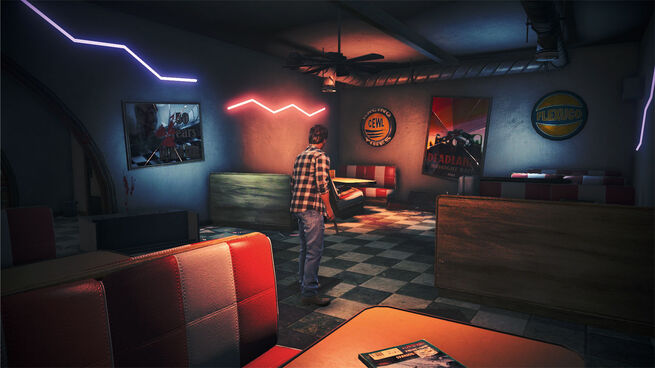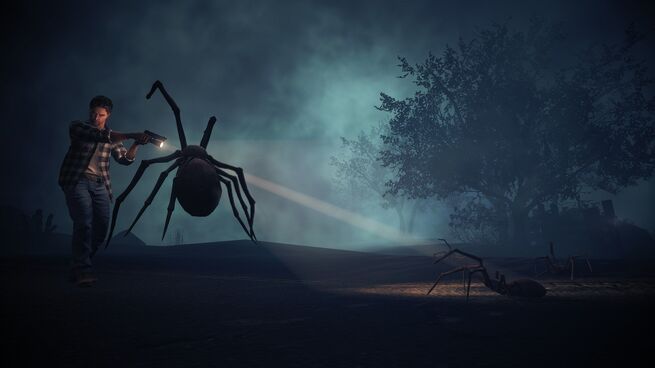
I could see when I booted up the game that something was different. The nature of the series was changing. It was apparent from the word go.
The words on the opening title screen read Alan Wake's American Nightmare, and although it bore the namesake of the original game from 2010, the overall image conveyed something undoubtedly pulpier in tone.
The title character appeared to be standing on the precipice of a desert cliff, flashlight in one hand and a nail gun in the other. He stood tall and held up the makeshift weapon confidently. Gone was the dark forest motif from the first game. No longer was Alan Wake just a name, a figure in silhouette behind a white beam of light. It was as if the character from that first game had re-written himself onto the cover of a comic book.
Whereas Wake's previous adventures had left him mysteriously stranded beneath the dark waters of Cauldron Lake, fighting for survival and sanity, this Alan Wake had emerged stronger and more powerful. Like a superhero.
As I progressed further into the main adventure, I began to see more clearly the game's overall structure. The Arizona setting presented itself as a series of small open-world environments that I was free to explore. I moved the player character around these bite-size locations, using a kind of on-screen radar device that pointed as a map and compass toward various objectives.
I knew that were I a stronger man I could cut straight to the main business, probably zip through the whole game in a few short hours. I could use those spared hours to do something productive and meaningful with my life. But I also knew that scattered around that digital landscape were collectible manuscript pages, and with those pages, Xbox achievement points.
I was not a strong man.
Even as the waves of enemies intensified, I never broke a sweat. I dispatched them with ease and precision. For being in a so-called “nightmare,” Alan Wake controlled like an absolute dream. His footwork was nimble. His aim was impeccable. And his ability to hold a flashlight steady on a moving target while reloading a pump-action shotgun? Effortless.
When it came to weapons and supplies, the game was more giving than Santa Claus. No matter the number of monsters that swarmed in a given moment, it simply didn't matter. A full or partial resupply of batteries, bullets and health was rarely more than a few hundred feet away.
On the one hand I could appreciate a game with a more buffed up protagonist. Easier combat meant less frustration. Less frustration meant less cursing at the television set. On the other hand, I couldn't help but feel the game lacked a certain tension because of this.
Within the game world I picked up page after page after page. Each time I did so I listened as the voice actor narrated. A few pages described plot events that had yet to transpire. Some filled in bits and pieces of backstory or brief subtext involving the game's minor characters. Most pages read like a boring, sentimental memoir. Alan had a loving wife. His agent Barry was a good friend. I wanted to shout at the TV. “I get it already!”
Alan Wake’s words had the power to reshape reality, but they also had the power to induce sleep.
In my own written review I had more-or-less forgiven the first game's sub-par prose, but this was getting ridiculous.

My wife had warned me that the game was recursive, requiring the player to repeat the same basic tasks in the same three locations, only with subtle storyline shifts.
Was this laziness on behalf of the developer, a way in which to recycle the same locations? Or was there a purpose? Did the storytelling communicate something significant through the use of this Groundhog Day setup?
Did developer Remedy leave room for surprises? Or did they merely throw in new weapons and enemy types with each recursive play through? It was hard to tell.
The premise of American Nightmare held promise. Alan Wake was hot on the trail of his nemesis Mr. Scratch, a doppelganger that was released into the world like an evil reflection when Alan plunged into the waters of Cauldron Lake at the end of the first game. Alan had written himself into some kind of vaguely remembered Night Springs television story in which he finally catches up to and corners Mr. Scratch.
Mr. Scratch had just wreaked strange havoc on this mysterious Arizona town. He had charmed many of the townspeople before turning violent and psychotic. He'd even recorded a series of taunting video messages, sometimes murdering random victims on camera while he waxed poetic to Alan about being nothing more than an unshackled version of Alan's true self.
There were other suggestions that this evil twin represented Alan's character flaws exaggerated to the extreme. The bad drinking habits. Alan's temper. But Mr. Scratch was also a serial killer, a concept all too morbid for such a lightly treated game.
Aside from those few drawn-out Mr. Scratch videos, most of the overarching story was simply implied. Alan encountered some non-player characters who briefly described the events that happened before his arrival. Events mostly disconnected from the player's rather straightforward experience of running around an empty game world and battling nameless dark creatures.
There was nothing wrong with the idea of a game bringing the player character into the aftermath of a calamity. BioShock and its spiritual predecessors were evidence enough of that. But American Nightmare violated one of the supreme rules of good narrative. Instead of showing, it mostly told.

When Alan Wake battled through the Pacific Northwest setting in the first game, the Taken had represented individuals who had been kidnapped by the elusive and unknowable Dark Presence. Loggers had been transformed into axe-wielding, chainsaw-revving murderers. Most of the Taken served as anonymous fodder that existed for the purpose of creating an obstacle to the protagonist's forward progress. But while their precise origins and identities may have presented a logical conundrum, they made enough aesthetic sense that it didn't really matter.
Their presence in American Nightmare felt more arbitrary. The enemies looked like cartoon characters in a cartoon setting. Alan's journey through the forests, farms, mills and mines of Bright Falls, Washington, had felt deeply authentic. The settings in American Nightmare—a generic motel, a mountain-top observatory, and a drive-in movie theater—felt haphazard by comparison.
Writing a game review is no easy task. People may think it's just words on a screen or a magazine page but it's not. There are considerations to be made. Will the review be a glorified consumer's guide? A think piece? Will it have a score or rating? A reviewer must identify a game's crucial components and determine either how well or poorly those components co-function to create an engaging or otherwise meaningful experience for the player.
I pored over the words I had written. My thoughts were as scattered and divided as the pages of Alan Wake's story. I had made a bold decision. I would try to write the review in the style of the author himself. I imagined Alan reading the prose as if it was his own. I searched in my memory for the rhythm and cadence of Alan's in-game narration.
Even as I struggled with the piece, I knew I was sacrificing the opportunity to put forth coherent criticism. My precious few readers would scoff. I might never be allowed to write for a respectable game publication because of it. It might not work. But I had made my decision. I'd gone all in. My chips were on the table and there was no turning back.
I started in on the third and final cycle of the game's narrative. The Alan Wake character had woken up once again on the shore of a small desert lake. In front of the character was the famous cabin from the island on Cauldron Lake. Like the Kansas farmhouse from The Wizard of Oz, it had been transported to a distant world. Only now it was partially submerged, sinking slowly into the dark sludgy waters.
Perhaps it was a metaphor for the character, trapped as he was in some metaphysical limbo of his own psyche. But it was more telling than that. To me the sinking cabin was symbolic of the Alan Wake series itself. The game that had begun with such potential had suddenly stagnated. The game developers had taken their narrative in a certain direction and now they were creatively stuck.
There was a time not long ago when I believed Alan Wake was on the cutting edge of some great shift in interactive storytelling. The first game had spun a gripping supernatural narrative that rivaled the best of high-concept television. Its linear level design worked brilliantly in episodic format, as each segment brought the game's protagonist ever closer to solving the mystery of his wife's disappearance. It was exciting.
American Nightmare felt like a video game. And an average one at that. It was possible this was just a diversion. A quick stopover on the way to a true sequel in which the developers at Remedy would pick up the pieces and continue the main storyline that had culminated to such great effect with their last downloadable episode. Only time would tell.
For now there was nothing to do but fudge around with American Nightmare's arcade action mode. As I preceded to play a thought came to me. “Hey,” I told myself. “This arcade action mode will really boost the game's replay-value score in my review.”
 Alan Wake's American Nightmare gets 2.5 out of 4 stars. You can download this game on Xbox LIVE Arcade for 1200 Microsoft Points ($15).
Alan Wake's American Nightmare gets 2.5 out of 4 stars. You can download this game on Xbox LIVE Arcade for 1200 Microsoft Points ($15).Images were borrowed from alanwake.wikia.com.
Brilliant ending, and a great review. I really like the choice to write in Alan's voice. As I haven't played the game, I didn't get it until you let us in on the secret, which is why I'm glad you did.
ReplyDeleteIt gives people who haven't played a taste of how it might feel to play, and, I imagine, those who have played (thoughtfully) will get it immediately.
Nice. Too bad it's not a great game.